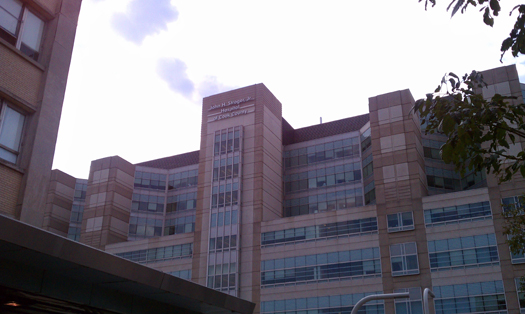| « Bet Your Bottom Dollar | TIFs and the Race to the Bottom » |
Health Care Thu Sep 15 2011
To Treat Everyone, Part One: Stroger Hospital
This is Part One of a series examining health care in Cook County.

The lobby for John H. Stroger, Jr. Hospital of Cook County, is a clean, bright, modern space. On the left side of the lobby are a gift shop and coffee counter run by the auxiliary board, which uses the money to help buy furniture for the hospital and gifts for mothers that give birth in the hospital. In the center of the lobby is an information desk where a sign telling visitors to get in line sits at the front of a roped off area to contain the line. The windows near the elevators are large, allowing those waiting to see greenery around the Stroger campus as well as the older Fantus Health Center building while sun streams through the windows.
What is the oddest thing about Stroger Hospital is that it does not seem to fit any conception of a public hospital most people hold.
The hospital opened in December of 2002, replacing the old Cook County Hospital that was built in 1914 and is still standing on Harrison Street, empty as it overlooks the Eisenhower Expressway. While the old hospital is grey, covered in some tags and numerous metal reinforcements that keep the stone of the building from falling to the ground, Stroger Hospital's exterior is large, boxy, but a structure that manages to look inviting with the numerous windows and bright purple signs in English and Spanish that seem suitable for the architecture of the building. Yet as you stand at the Illinois Medical District Blue Line stop, Stroger Hospital almost seems hidden behind the old hospital, only a portion of the current flagship hospital sticking out.
This could be a symbol for the current hospital. If you ask the average Chicagoan, they may say they think Stroger Hospital is the empty building on Harrison, dirty, overcrowded and plagued by long waits in the emergency room. According to Sonja Vogel, Communications and Marketing Director for Stroger Hospital and the Ambulatory and Community Health Network (ACHN), a challenge they do face is informing people that the hospital isn't in the old building. Stroger continues its efforts to have the hospital run efficiently and minimize waiting times.
As the flagship hospital in the Cook County Health and Hospitals System (CCHHS), Stroger Hospital serves everyone, regardless of their ability to pay, with the intent to give them the best care possible. In 2009, the emergency department treated 137,919 people, 4,959 visits were for trauma. (The link opens a PDF file that has data for all of the following hospitals.) Elsewhere in Chicago, Advocate Illinois Masonic Medical Center in Lakeview had 1,319 trauma visits that year and 40,342 ER visits. Northwestern Memorial Hospital in Streeterville had 738 trauma visits and 81,049 ER visits. Mount Sinai Hospital in Lawndale had 8,327 trauma visits and 47,418 ER visits. University of Chicago Medical Center and Mercy Medical Center, both of which have no Adult trauma center, had 73,921 and 52,101 ER visits respectively. Meanwhile at Stroger, 916 live births were performed at the hospital and 615,650 outpatient visits were made. The hospital claims to have one of the largest and busiest emergency departments in the nation.
In the past century, public hospitals in America have been plagued by problems ranging from budget issues, poor upkeep and mistreatment of patients. The most notable example of the failure of public hospitals to treat the poor and uninsured is Martin Luther King Jr./Drew Medical Center in Los Angeles County, which became known as "Killer King" because of the deaths that resulted from incompetence from its staff. After a Pulitzer Prize winning investigation by the Los Angeles Times, King/Drew's problems came to light and it was closed as a hospital in 2007, although it currently operates as an Ambulatory Care Center.
Yet the perceptions most Chicago residents have of Stroger Hospital seem to be myths, the result of our country's overall perception of public medicine. If one looks back at the debates over the Health Care Reform bill passed last year, arguments were made that single-payer health care would result in health care that was not of the highest standard. The general view seems to be that any hospital started run by the government that isn't a Veterans Affairs hospital is a chaotic mess where patients are given substandard care.
Prior to 1986, an act referred to as "patient dumping," where patients who were uninsured or unable to pay for emergency treatment were transferred to public hospitals by private hospitals, was rampant and reported publicly in the New England Journal of Medicine by doctors at Cook County Hospital. In 1986, the Emergency Medical Treatment and Labor Act was passed as a part of COBRA and requires all hospitals that participate in Medicare to do a screening examination and stabilize any patient that enters an emergency room seeking treatment for an emergency condition, regardless on their ability to pay, or transfer the patients if the hospital is unable to provide the treatment needed. Any hospital that discharges or transfers patients when their condition has not been stabilized can be fined by the federal government.
There don't seem to be many indicators suggesting Stroger Hospital is a place where no one in Chicago would want to end up. Beyond the inviting lobby, there is evidence that the hospital was built with the intention to create an efficient way to serve its patients, primarily the busy ER that has divided its trauma center, emergency room and pediatric emergency department to lower waiting periods and allow patients to be given the treatment they need as soon as possible.
On a Friday afternoon in early September, the trauma area was very empty, only one bed seemed to occupied, but Vogel said that all of the beds are filled on weekends as gunshot, stabbing and car accident victims are in for treatment.
The pediatric emergency department, which cares for about 13,000 patients each year, appears to be smaller than the trauma area, but has a separate waiting room than the rest of the emergency department.
The main emergency department has a large open waiting room where patients and their families or those that came with them wait before patients are taken in for triage, and then treatment. For patients who aren't presenting severe conditions, but go to the ER because they don't have a primary care physician, the hospital triages these patients differently to keep the department moving efficiently.
The adult emergency department is also broken down by three different categories, red team, blue team and green team. Red team treats patients with high-acuity medical conditions and surgery, blue team treats low to moderate acute medical patients, as well as conducting psychiatric assessment; green team specializes in minor treatment such as eye problems, minor trauma and asthma.
The hospital's services extend beyond the emergency department. Deeper inside the hospital are specialty outpatient clinics including ophthalmology, urology, and gastroenterology. There are 50 different specialty clinics that serve more than 230,000 patients yearly. These clinics are divided by the specialties and have separate waiting rooms. Additionally, the hospital has two pharmacies, one for inpatient and another for outpatient prescriptions.
Additionally, the Cook County Health and Hospitals System (CCHHS) launched an appointment scheduling system in November 2010 that will reduce waiting times and make it easier for patients, allowing them to not have to wait around all day to see a doctor. Around the first floor of Stroger Hospital, posters hang on walls reminding patients that they can schedule appointments ahead of time. According to Vogel, they are still trying to get patients used to the system.
Although the emergency department and trauma unit are well respected, other parts of the hospital are viewed as being state of the art and even among the best in Chicago, including their burn unit and neo-natal intensive care unit (NICU). The NICU nurseries sit in the maternity ward, where blankets with colorful designs or images of animals on them cover incubators. In this nursery, a bright playful wallpaper border sits at the top of the wall. While some of the infants in this unit were born prematurely, some infants that are young and become very ill are taken to this unit, regardless of their size, according to Paweema Glapajone, a nurse in Stroger Hospital's NICU.
Glapajone has been a nurse at Stroger Hospital and its predecessor for 23 years and seems like a wise, yet cheerful nurse. As a nurse for the hospital, she started taking pictures of mothers with their newborn babies with the permission of the families. She then prints the pictures and frames them, giving them as gifts to the mothers before they leave the hospital. Near the nurseries the photographs she's taken are framed and hang on the walls.
Some might think a NICU would be depressing because of the patients it takes care of, there is a peaceful nature to this area because of the staff as they watch over the infants. The NICU has 52 beds and has a Level III rating, the highest rating a NICU can receive in Illinois. According to Vogel, the unit receives transfers from other hospitals because those hospitals cannot provide the care the newborns need, while Stroger Hospital can.
Because of the ability to provide care to infants who need very specialized care, the hospital can take care of infants that many people would think have a small chance of survival. It may be the environment and staff of this area that provides peace to the mind when you see such a small child hooked up to tubes and cables, a lamp keeping them warm, a terrifying sight when our minds typically associate birth as resulting in a healthy baby being wrapped in blankets and handed to their mothers to be held, requiring two arms to cradle them.
One of the more notable differences between the current hospital is the labor and delivery process for Stroger Hospital. According to the book County: Life, Death and Politics at Chicago's Public Hospital by Dr. David Ansell, a former doctor at Cook County Hospital and current member of the CCHHS Board of Directors, the delivery at the old hospital was referred to as the "Labor Line" and numerous women would be in a room, laying on stretchers while having contractions, lacking in privacy as they went through the pain of labor. The rest of Stroger Hospital has a mixture of private and semiprivate rooms, but the delivery rooms are all private, a vast improvement from the old hospital.












get real / September 17, 2011 6:44 PM
Thanks for the press release from what must have been one of Cook County's resident PR hacks